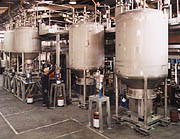
The smell of spirit-based paint, varnish and glues is a familiar one, and can accompany the emission of VOCs, which are harmful to the ozone layer and contribute to the greenhouse effect.
A massive change from solvent- to waterborne finishes is encouraging significant innovation in mixing methods. A new mixing technology known as NIMIX mixes fluids with zero emissions, and has found a diverse range of applications — from coatings to mixing casting slurry for golf clubs. The technology’s bottom-to-top blending method, using an oscillating plate, is causing a stir without an impeller in sight!
Conventional mixing machines stir the vessel contents like a kitchen mixer, using a shaft and impeller arrangement. They are usually open to the atmosphere, and odors and emissions, which occur during the process of blending or re-suspension, naturally pervade the workplace and eventually escape to the atmosphere.
NIMIX mixes in a closed environment and — instead of stirring the contents — it circulates them from bottom to top. Vibration, or oscillation, is the driving force for the mixture, which is in effect pumped through specially shaped holes in a ‘diode’ plate causing flow up through the middle of the vessel contents and down the sides. This method is an efficient low-shear process, and is particularly effective for liquid/solid suspensions. The low-shear nature of the process means that suspended particles in the mix are not damaged or broken down by the mixing action.
The coatings industry has been quick to take advantage of this process. General industrial coatings make up almost half of the total market, and over a million liters per year are used for finishing furniture, machines, and equipment. Solventborne finishes for the furniture industry have been ‘outlawed’ in Europe and the EPA required all manufacturers to change to environmentally friendlier coatings by April 1999. Waterborne coatings are, in most cases, replacing the old finishes.
Sonneborn & Rieck, a leading manufacturer of wood coatings for the furniture and woodworking industries, adopted the new NIMIX-based method of production in anticipation of the already-rising demand for waterborne, environmentally responsible finishes. Typically for the furniture and woodworking markets, coatings produced by the NIMIX-based process have two key advantages: they are mixed and kept in suspension in a totally enclosed environment, and there are only low VOC emissions from the new waterborne coatings.
Sonneborn & Rieck had been producing solventborne wood stains using a number of conventional mixing systems. Required to switch to a new range of waterborne wood stains, they were faced with the need to buy new processing equipment. They had two options: to continue with their familiar conventional technology, or to introduce a different one.
The company decided to spend time evaluating NIMIX mixing technology to see if it could reach its goal of improved customer service with reduced finished product stocks. NIMIX offered key benefits; the first was the ability to effectively mix a range of volumes in any one mixing system. For example, a 5,000-liter mixer can mix down to 500 liters very easily. The second key benefit is the ability to rapidly mix the product without aerating it, thereby reducing standing time to a minimum before filling off. Finally, the easy cleaning of the system with very little cleaning fluid was appealing.
Sonneborn & Rieck evaluated these advantages with a trial 1,000-liter mixing system over a three-month period at its Chesterfield production site. This was one of a fleet of such test systems NIMIX can make available to prospective customers to evaluate the technology.
The test system was supplied to site; NIMIX personnel trained Sonneborn & Rieck’s production staff in the use of the equipment, and then manufactured a first batch of material on the system. The batch clearly showed the ability of the system to blend colors with no aeration and, after quality approval from the laboratory, the batch was filled off.
The second batch made the wood stain from scratch. Incorporation of a matting agent was again achieved with no aeration and the batch was filled off after the usual quality-control checks. Following successful completion of the first two batches, the test system was left at Chesterfield so that test batches could be manufactured as and when required. In fact, the system was used to produce a number of test batches over the coming months, and these were supplied to end users’ sites for product evaluation and acceptance trials.

Once the finished product had been approved by the end user, Sonneborn & Rieck and NIMIX Limited met to draw up a specification for a new plant. The new plant would incorporate all the advantages demonstrated during the trial batches and scale the process up to 5,000 liters from the trial 1,000-liter system. A full plant design was agreed between the two companies and a full hazard and operability study was conducted. This study produced a few alterations to the plant design and layout. The final design was agreed, the order placed for the new plant, and the custom-designed NIMIX woodstain plant was installed at the Chesterfield production site.
Sonneborn & Rieck say that the new plant represents a major new investment that will give the company greatly increased production capacity, putting it in the front rank of global coatings manufacturers.
In operation, the NIMIX plant offers not only high throughput rates but remarkable levels of flexibility, being able to switch rapidly from one type of finish to another while maintaining high throughput. An S&R representative says, “Our plant design incorporates high levels of flexibility, enabling a wide range of different products — lacquers, stains and waterborne UV — to be manufactured while maintaining low lead times. It means our customers can get exactly the finish that meets their need and get it remarkably swiftly.”
Sonneborn & Rieck also says that the technology has helped to eliminate the problems that can afflict waterborne production. In the furniture business, many small- to medium-sized manufacturers need to buy small quantities of waterborne coatings because consumers’ tastes vary and a range of colors and finishes is needed to remain competitive. NIMIX mixing equipment is accommodated in the bottom of the vessel and product can be made in a wide range of quantities from full vessel right down to almost empty. The technical term is turn-down ratio. The turn-down ratio of a NIMIX system is far greater than impeller-mixers, enabling a wide variation of batch sizes to be manufactured in a given vessel.
Sonneborn & Rieck’s new plant consists of two 5,000-liter tanks and two 2,000- liter tanks, each made from stainless steel. Raw material is supplied by two 20,000- liter resin tanks. Production plant is mounted on digital load-cell weighing equipment with a direct linkage between each individual vessel, thus enabling many variants of finishes to be easily produced.
Clearly, the change to waterborne finishes will place a burden on manufacturers but S&R points out that, “The extra capacity available, coupled with the technical expertise, will enable Sonneborn & Rieck to provide exceptional support for its customers during a difficult period of change.”
The new production plant is a result of technology researched and developed by BHR Group Limited. It results from 10 years of careful and thorough development and is the invention of Dr. Geoff Pollard, one of BHR Group’s consultant engineers.
Barry Sullivan, general manager of NIMIX Limited, comments, “In the last three years, we have supplied over 170 NIMIX systems to users around the world for a range of coatings operations. Our systems are used in a wide variety of operations, from making NC solutions to blending and reducing aeration, and supplying marine coatings to shipyards. We have also supplied NIMIX systems for mixing foodstuffs and pharmaceuticals.”
For more information on mixing, contact Ed Bloomfield, External Relations Manager, BHR Group Limited, The Fluid Engineering Centre, Cranfield, Bedfordshire MK43 0AJ United Kingdom; phone 44(0)1234 750422; fax 44(0)1234 750074; visit www.bhrgroup.com; e-mail ebloomfield@bhrgroup.com.


Report Abusive Comment